The Five Best (and Five Worst) Status Quo Changes in Superhero Comics
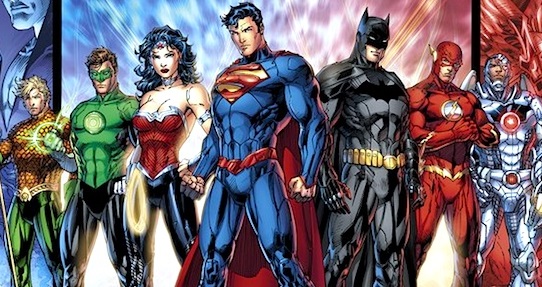 |
For the most part, superheroes in American comics are ageless and timeless; outside of Elseworlds tales and “imaginary” stories, the heroes in comics never age much, or have too much of their world around them change significantly. On occasion, though, the status quo will change in comics, giving writers (and fans) a new paradigm to play in. Sometimes it works, and the new status quo is around for the long haul, or at the very least, a very long time. Other times it doesn’t work, but the editors try to force it down our collective throats anyway. Here are the five worst, and five best, major status quo changes in superhero comics.
The Five Worst Status Quo Changes
5. Mutant Decimation as a Result of House of M
 |
House of M, Marvel’s mega crossover event for 2005 by writer Brian Michael Bendis and artist Oliver Coipel, was in and of itself a decent mini-series. The basic premise of House of M was that the Avengers and the X-Men, fearing how powerful the Scarlet Witch’s reality altering powers had become since the events of Avengers Disassembled, get together and “do something about it.” What they basically decided to do, or at least seriously considered “for the sake of the world”, is kill the Scarlet Witch before she can alter reality again. The Scarlet Witch’s brother Quicksilver warns her of their plan, and before the heroes can lift a finger, she alters reality to fit her needs and give all the heroes their heart’s desires. By the end of the series, the heroes see through the new altered reality, and in a final act of spite against her father Magneto, Wanda Maximoff utters the words “No More Mutants” -and 99.9 % of the world’s mutant population loses their powers in one grand gesture
.
The idea for this change, as per Marvel EIC Joe Quesada, as that there were simply too many mutants running around the Marvel Universe, and way too many mutant titles, and their status as a hated minority didn’t make sense anymore if there were just so darn many mutants. Never mind that actual numbers don’t always factor into prejudice (women make up more than 50% of the population of Saudi Arabia too; doesn’t stop the the men from being prejudiced against them) by reducing the mutant population to just 198 people, well… that’s not a race anymore, that’s just a really good turnout for a party.
Add to that the fact that the 198 mutants were essentially all the mutants we already knew about, so the same amount of mutant super heroes and villains were running around the Marvel Universe as before. All Joey Q took away was the idea of the mutants we didn’t see, the ones who weren’t heroes or bad guys, the “little guy” everyday Joe mutant who the X-Men were defending. The main metaphor of what the X-Men was all about was suddenly neutered, and it would be another seven years (at the end of Avengers Vs. X-Men) before the whole endangered species part of mutantcy was finally over, and new mutants started popping up again. And it’s no coincidence that the X-Men titles have been better than they’ve been in years with the central metaphor restored once again.
4. Spider-Man’s Marriage is Nullified by the Events of One More Day
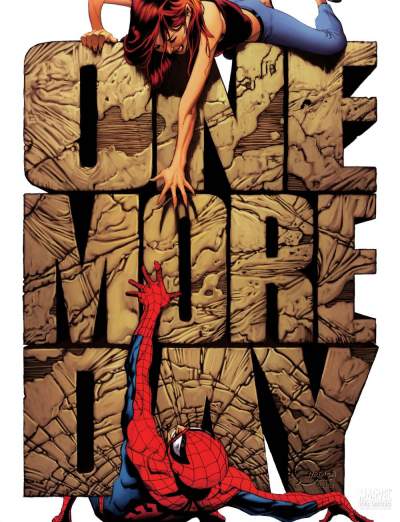 |
Back in 1987, Marvel Comics finally had Peter Parker marry his longtime girlfriend Mary Jane Watson, in a big media blitz that got them lots of mainstream attention. From the sound of things, the folks at Marvel instantly regretted that decision, as having a married Peter Parker “aged” Spider-Man too much in their eyes. Although I think the idea of having super heroes be eternally twenty-something is kind of stupid (I really don’t think the readership cares at all if, say, Batman or Cyclops is forty) I do understand how youth is part and parcel of the appeal of what Spider-Man is all about. Nevertheless, the decision was made to have him be a married man, and for years Peter Parker was married to the hot redhead of his dreams. In fact, a whole generation of Spidey-fans grew up knowing only that version of the character.
But Marvel EIC Joe Quesada really hated the notion of a married Spidey, and in 2007, in writer J. Michael Straczynski’s final issue of The Amazing Spider-Man, the entire marriage is undone in one giant retcon. After Peter’s Aunt May has been shot, Spider-Man seeks mystical help to save her life. He encounters the demon Mephisto (who is essentially Satan) who offers to save her life if Spider-Man “gives him” his marriage. Spider-Man and Mary Jane agree to this, and that part of their history is erased so that, effectively, they have never been married in the first place.
To say fans hated this is something of an understatement. Even fans who agreed Peter should be single again for the sake of story thought the whole “wave the magic wand” retcon was one giant cheat. Giant continuity altering retcons were DC’s deal; Marvel prided themselves on being more “real.” So why not have Peter and MJ get a divorce? Or have MJ die? Any of those options would have been preferable, and many readers abandoned the Spidey books for good at this point, especially those who grew up with a married and happy Peter and MJ. It’s been six years since One More Day, and the readership has more or less gotten used to the new status quo, but there are still readers out there who feel slighted by Marvel for the how the whole thing went down.
3. The Justice League Icons Are Replaced by Nobodies
 |
Sometimes, it pays to follow trends. Other times… not so much. In 1980, DC saw the tremendous success Marvel’s X-Men was having, where they took a second tier title from the sixties, kept the basic premise and a couple of key players, and heavily revamped the rest. DC took this same tack with their revival of the Teen Titans, a very broad and goofy comic that was never much more than a second tier book in its day. Much like Marvel with X-Men, they kept a couple of key players – in this instance Robin, Wonder Girl and Kid Flash – and introduced four new characters to the team who would quickly prove to be the team’s most popular members. New Teen Titans took the X-Men formula to runaway success. DC then tried to do the exact same thing with their flagship team book Justice League of America…and failed pretty miserably.
In 1984, DC had key, iconic JLA members Superman, Wonder Woman, Flash and Green Lantern leave the title (Batman had left the year earlier to form his own team, The Outsiders.) In their place, the second tier JLAers like Aquaman, Martian Manhunter and Zatanna stayed on, leading an all new band of hip, young heroes. Well, they seemed hip and young to the forty somethings who wrote the book at the time anyway. There are a few reasons why this revamp failed: first off, unlike the Avengers, the League had a very steady line-up for almost a quarter century at that point. The Justice League were like the Elks Club for heroes, membership was for life, and new members were added very, very carefully, with few leaving for long. Wonder Woman most famously left when she lost her powers, and when she got them back the JLA made her prove herself worthy of rejoining, which, frankly, was kind of a dick move. But it illustrates the key difference between the JLA and the Avengers: The League did not just allow any superhero to join their esteemed ranks.
So in 1984, to suddenly have all the icons leave the book and replaced with cliches of 1984 MTV pop culture, like a breakdancer, Tina Turner and Madonna look-alikes, and a poster child for the 1984 USA Olympics Team, well…it was just doomed. Sure, JLA needed a revamp, but this one was wrong headed and painfully out of date a mere two years into it. Some team books thrive on constant membership changes, but others, like the Fantastic Four and the Justice League, always work best when the original concept is being done right.
2. Marvel Civil War’s Four Year Long Aftermath
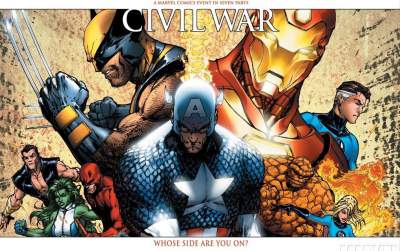 |
Marvel’s 2006 event mini series Civil War was a pretty damn good read from writer Mark Millar and artist Steve McNiven. It created a scenario that had hero vs hero without a definite “bad guy” to root against, and managed to invoke modern real-world politics and issues regarding what we as a society are willing to do in the name of safety and security, all while still being wrapped up inside a fun comic-book superhero saga.
But as cool as the initial mini series was, the fallout and status quo change in the Marvel Universe went on for years, arguably at the very least two years too long. In the post Civil War Universe, Tony Stark, the leader on the side of government registration of known superheroes, was portrayed as kind of a giant prick, as was every hero on the registration side, regardless of whether or not they actually had a point. Meanwhile all the heroes on the side of those against hero registration were painted as cool rebels. Despite saying that Civil War had no clear villains, it was clear that Marvel were painting the pro-reg side as the bad guys. The massive split between the hero community was interesting at first, but shouldn’t have played out for more than a year or so. Instead, it continued on for something like four years, until the events of the 2010 Marvel event series Siege finally ended the registration act and united everyone again as one big happy family of good guys. And It was a long time coming too.
1. Flashpoint Results in the “New 52” DC Universe
 |
This one is, as they say, still an open wound. In 2011, as a result of the time altering mini-series Flashpoint, the DC Universe underwent their biggest reboot since 1985’s Crisis on Infinite Earths. While Crisis was something DC desperately needed at the time, there is an argument to be made that the DC Universe was in no way “broken” as they were back then
in the day, and didn’t need to be “fixed.” Sure, sales were down at DC, but DC Editor-in-chief Dan Didio decided they needed to cancel their entire line (even long running books like Action Comics and Detective Comics) and start from #1 with an all new continuity. Actually at first, DC didn’t say this was a reboot, they said it was merely a relaunch – but it turned out it was indeed a reboot; they just didn’t want to use the word and get the longtime fans in a tizzy. It worked too – the New 52 relaunch sold like gangbusters, at least initially.
Unfortunately,the “New 52” DC Universe is kind of a giant hot mess of inconsistency, All the characters are supposed to have been around for just five years in this new universe’s timeline, making sure everyone is young and therefore appealing to teens and twenty-somethings (despite the fact that most comic book readers are in their 30s at this point.) Which means Batman has had five Robins in as many years, Superman has armor for some reason, and Wonder Woman now acts more like Xena and even has her origin to boot. She’s apparently dating Superman too, but you wouldn’t know that from reading her title, where he never appears. The Flash is once again Barry Allen, and although that book has been solid, the lack of the concept of the “Flash Family” and legacy means it lost something that made it unique. Green Lantern got by unscathed, due to his popularity, but his history makes as much sense as Batman’s now that it’s in a five year timeline. Sales are back to where they were pre-New 52, and someone at DC has got to be wondering if the whole damn thing was worth it. Marvel was wise; they saw what DC did right and what they did wrong with the New 52, and they relaunched their whole line at #1 with the Marvel NOW initiative, but didn’t throw away their fifty-year continuity to do so.
The Five BEST Status Quo Changes In Superhero Comics
5. First Major Avengers Line-Up change With “Cap’s Kooky Quartet”
 |
When the Avengers debuted in 1963, they were essentially not much more than the Marvel version of DC’s Justice League of America. Stan Lee simply took all of his headlining heroes (minus Spider-Man) and put them together as one mighty team. The team could have remained as this JLA knock-off forever, and sales would have probably been fine, but a mere two years later, Stan shook things up big time, and had all the Avengers quit except for Captain America, who then recruited three former villains to the line-up – Hawkeye and mutant siblings Quicksilver and the Scarlet Witch.
It was daring, it was crazy, and it was an unqualified success, as “Cap’s Kooky Quartet” became fan favorites themselves. This move showed that Marvel was willing to do stuff that their “distinguished competition” would not, and the Avengers became a brand that was synonymous with constant change.
4. The Death of Gwen Stacy
 |
One of the sacred rules of superhero comics, at least in the first few decades of their existence, was that the hero always saves the day. No matter how many times the mustache-twirling villain has the damsel in distress tied to the railroad tracks, it never resulted in a bloody, awful mess, because the hero always won. And despite the many changes made by Stan Lee and company in the early Marvel days to elevate superhero comics into something more mature, by and large, during Silver Age Marvel, the hero always won in the end still. That all changed with Amazing Spider-Man #122, published in 1973, where the Green Goblin’s plan ends up killing the love of Peter Parker’s life, Gwen Stacy.
This one event sent shock waves among comics fans, with hundreds writing in to the Marvel offices angrily wondering how they could do something like this. Stan Lee was even doing damage control on his college campus lecture tours, promising Gwen would be back some day. (She never did come back.) The death of Gwen Stacy was seen by many as the start of the “Bronze Age” of comics, were the same Silver Age characters were still being used (unlike the transition from the Golden Age to the Silver Age, where many characters were just replaced) but were starting to be handled in a more mature fashion. The death of Gwen Stacy meant anything could happen in the pages of Marvel Comics, there were seemingly no sacred cows anymore, even if really there still were. But for the average reader back then, the death of Gwen Stacy meant that now anything was possible, and that occasionally, the hero sometimes loses.
3. The Death of Robin
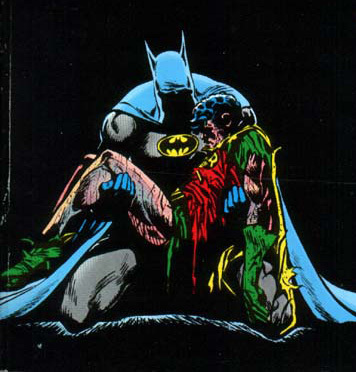 |
This one is significant for several reasons, reader participation being one of them, and remains significant, even though it was undone some 17 years later and the formerly dead character now headlines his own comic series. Back In 1988, Batman was right smack-dab in the middle of a new wave of popularity thanks to Frank Miller’s Batman: Year One and The Dark Knight Returns, not to mention Alan Moore’s The Killing Joke. Tim Burton’s upcoming Batman movie was creating mega buzz even in the pre-Internet age. Batmania: Phase II was upon is. But there was still that nagging reminder of the campy sixties Batman in the form of the kid sidekick with the little green trunks and the pixie boots. Even though this Robin was Jason Todd, as Dick Grayson had graduated to Nightwing at this point, it didn’t matter: what Robin symbolized mattered, and to readers of the time, he made them think of Burt Ward and Superfriends. He had to go.
So at the end of the 1988 story A Death in the Family, DC put it up to the readers to vote if Robin should live or die, after being beaten brutally with a crowbar by the Joker. They were asked to call a 900 # and cast their vote, and Robin was voted to die. The bloodthirsty masses had spoken, and so it was done. This change gave an extra gravity to the Batman mythos, though, as Robin was more powerful as a costume hanging in memoriam than as a living character, a constant reminder for Batman of his one great mistake that he couldn’t ever undo. Although DC swore for years that Jason Todd’s death would never be undone, in 2005 writer Judd Winick did just that, and Jason returned from the grave as the anti-hero called the Red Hood. Marvel did a similar story with the return of Captain America’s kid sidekick Bucky, but where that met with much praise, Jason’s return has been viewed more skeptically. Although I have read some decent stories featuring Jason Todd since his return, I’m still not convinced they were good enough to have his death reversed entirely – one of the biggest and most important status quo changes in Batman’s 70+ year history.
2. The Introduction of the All-New, All-Different X-Men
 |
It is hard to believe now, but once upon a time, The X-Men series was cancelled. From 1970 to 1975, there were no new X-Men stories being published by Marvel, and it is doubtful that many fans back then even cared. Although they debuted in 1963 in a comic from the powerhouse team of Stan Lee and Jack Kirby to a decent amount of success, within a year and half Kirby left the book and sales never really recovered. Although never an out-and-out bomb (in 1969, the year they were cancelled, Uncanny X-Men outsold Justice League, Flash and Detective Comics) X-Men still wasn’t seen as something worth continuing with new stories. The X-Men book continued on as a reprint title, until they finally ran out of stuff to reprint. It was then someone at Marvel had the genius idea of revamping the book completely.
The X-Men were no longer the five teenagers under the tutelage of Charles Xavier, they were an older crop of international mutants, including the German Nightcrawler, the African Storm, the Russian Colossus and of course, the Canadian Wolverine. The only female holdover from the old team, Jean Grey, was elevated to the Phoenix, and was now the most powerful hero in the Marvel universe. Within five years, the Uncanny X-Men were Marvel’s biggest selling title, and under the care of writer Chris Claremont and artists Dave Cockrum and John Byrne, they advanced superhero storytelling in much the same way Stan Lee and Jack Kirby had advanced it from the DC Silver Age goofiness a decade earlier. Because of this success, the X-Men became a franchise, a franchise that kept the entire comic book industry afloat during many troubled times for the comic book industry.
1. The Post- Crisis on Infinite Earths DC Universe
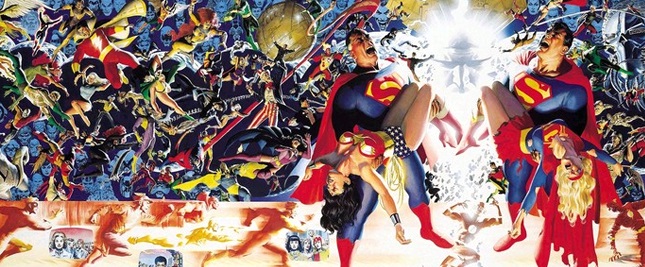 |
In the early eighties, DC Comics was a company in serious trouble. They were the home of some of the most famous and heavily licensed characters in the world, but sales on their comics were mostly terrible. Marvel was outselling DC by something like two to one. The only comics that were making a profit or had any kind of success were The New Teen Titans and (believe it or not) The Legion of Super-Heroes. There was no buzz around books like Superman, Batman and the rest; they were viewed by modern comic book fanatics as relics of a bygone era in their execution. At one point, Marvel almost bought the license to the DC characters, it was that bad. So in 1985, DC decided they had to make a drastic change. They rebooted almost their entire universe in the twelve part mini-series Crisis on Infinite Earths.
The end results of the newly revamped DC Universe were some of the very best superhero comics ever produced; John Byrne’s Superman reboot Man of Steel, Frank Miller’s Batman: Year One and George Perez’ re-imagining of Wonder Woman all breathed much needed new life into these old icons. Gone were many tired old tropes associated with the characters, and they all felt fresh again for the first time in decades, and those just mentioned characters were just the tip of the iceberg. Although not in continuity per se, DC also produced Watchmen and The Dark Knight Returns during the post-Crisis period. It was a golden era for DC, and certainly in the case of Batman, he’s never been unpopular again. The post-Crisis DCU had its share of hiccups, but the new improved quality made it all totally worth it. The post-Crisis DC Universe was the template for how a good reboot was done.
Previously by Eric Diaz:
The Top Ten Substance Abusers in Comics
Nine Reasons a Flash TV Show Could Be Better Than a Flash Movie
The Ten Heroes Most Unworthy Of Justice League Status (Who Joined Anyway)
